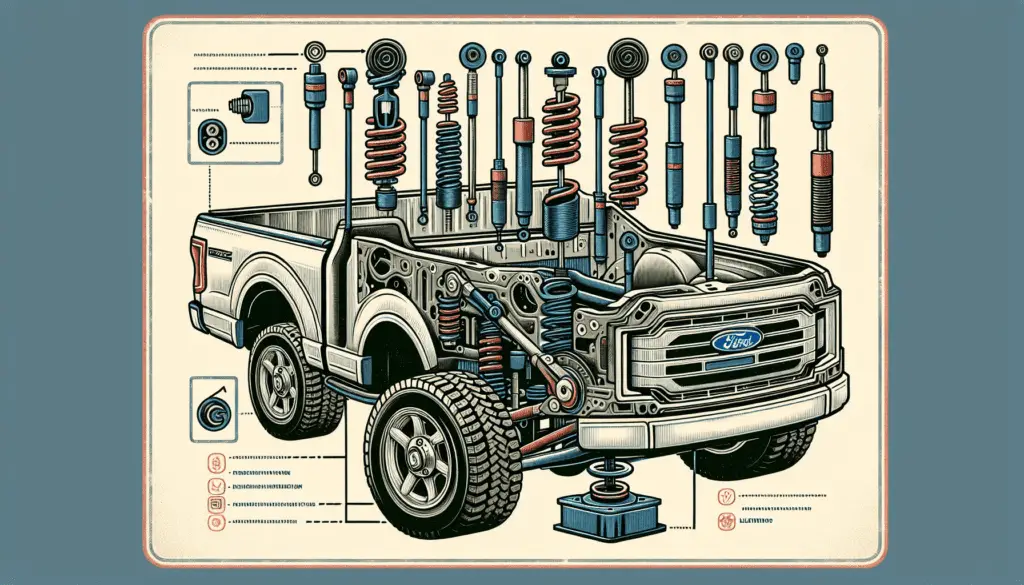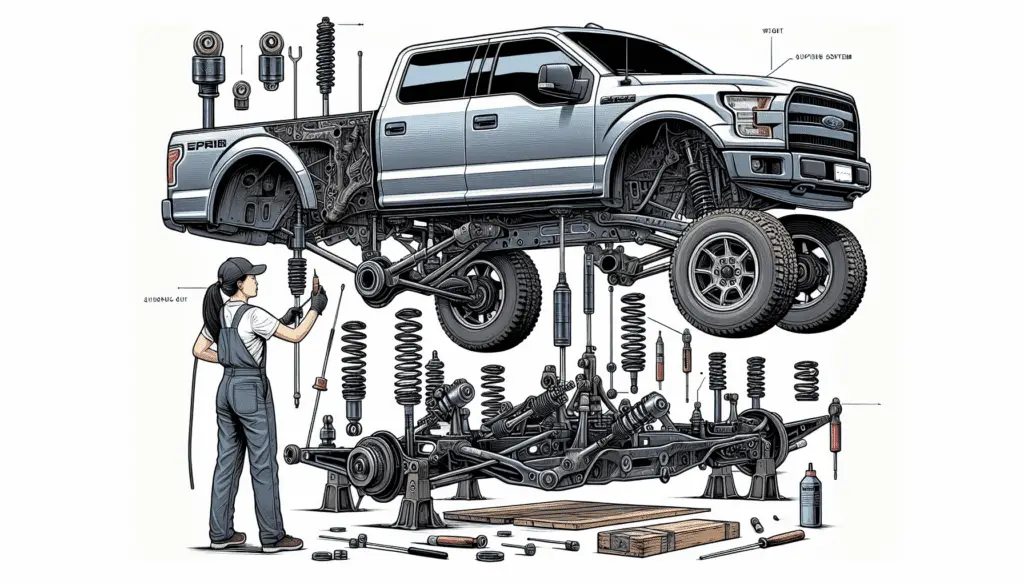Maintaining a healthy suspension is crucial for the optimal performance and longevity of your Ford truck. From ensuring a smooth ride to enhancing vehicle stability, the suspension plays a vital role in your driving experience. In this article, we will explore the essential steps you can take to properly maintain your Ford truck’s suspension, allowing you to breeze through the roads with confidence and ease. So, let’s dive right in and uncover the secrets to keeping your truck’s suspension in top-notch condition.
Inspecting Your Suspension
When it comes to maintaining your Ford truck’s suspension, the first step is to thoroughly inspect it for any signs of damage. Look for any visible cracks, dents, or other forms of wear and tear on the components. Check for loose or missing bolts and nuts, as they can compromise the stability of your suspension. In addition, pay close attention to any unusual noises or vibrations while driving, as they could indicate a problem with your suspension.
Check for signs of damage
Inspecting your suspension for signs of damage is crucial for maintaining its functionality and overall performance. Look for any visible cracks, dents, or corrosion on the various suspension components. Pay close attention to the control arms, ball joints, and shocks and struts. If you notice any damage, it is important to address it promptly to prevent further complications.
Look for worn-out components
Worn-out suspension components can significantly impact your driving experience and safety. Inspect the springs, bushings, and other suspension parts for any signs of excessive wear and tear. Be on the lookout for sagging or damaged coil springs, cracked or deformed leaf springs, and worn-out bushings. If any components are in poor condition, it’s essential to replace them right away to ensure optimal suspension performance.
Inspect the shocks and struts
The shocks and struts play a critical role in maintaining a smooth and comfortable ride. Regularly inspect these components for any signs of leakage, excessive wear, or damage. If you notice oil residue on the shocks or struts, it could indicate a leak. Additionally, pay attention to any bouncing or excessive body roll while driving, as it may suggest that these components need to be replaced.
Check the suspension bushings
Suspension bushings are responsible for absorbing shocks and vibrations, enhancing the ride quality of your Ford truck. Over time, these bushings can wear out or become damaged. Inspect them closely for any signs of cracks, tears, or excessive play. If you notice any issues with the bushings, it is recommended to have them replaced to maintain the stability and performance of your suspension system.
Inspect the control arms and ball joints
The control arms and ball joints are essential components of your Ford truck’s suspension system. Inspect them regularly for any signs of wear, play, or damage. Check for any excessive movement or looseness in the control arms and ball joints, as these can negatively impact the handling and stability of your vehicle. If you notice any issues, it is important to address them promptly to prevent further damage and ensure your safety on the road.
Maintaining Suspension Components
To keep your Ford truck’s suspension in optimal condition, regular maintenance is key. Here are some essential steps to take in maintaining your suspension components:
Regularly clean and lubricate components
Keeping your suspension components clean and properly lubricated is essential for their longevity and smooth operation. Regularly clean off any dirt, debris, or road salt that may accumulate on the suspension parts. Use a gentle soap and water solution to clean the components thoroughly. After cleaning, apply a suitable lubricant to the moving parts of the suspension to minimize friction and wear.

Inspect and replace worn-out parts
Regular inspection of your suspension components is crucial for identifying any worn-out parts that may need replacement. Pay attention to any signs of excessive wear, cracking, or deformation. If you notice any issues, it is important to replace the damaged parts promptly to prevent further damage to your suspension system and ensure your safety on the road.
Grease the suspension fittings
Properly greasing the suspension fittings is essential for maintaining smooth and quiet operation. Apply a suitable grease to all the grease fittings on your suspension components. This will help reduce friction and wear, prolonging the lifespan of the parts and ensuring optimal performance.
Tighten loose bolts and nuts
Loose bolts and nuts can compromise the stability and safety of your suspension system. Regularly check all the bolts and nuts on your suspension components to ensure they are properly tightened. If you notice any looseness or play, tighten them immediately. However, be careful not to over-tighten them, as it can cause damage to the components.
Maintain proper wheel alignment
Maintaining proper wheel alignment is crucial for ensuring the optimal performance and longevity of your suspension system. Regularly check your Ford truck’s wheel alignment to ensure that the wheels are aligned according to the manufacturer’s specifications. If you notice any irregular tire wear or pulling to one side, it is recommended to have your alignment checked and adjusted by a professional.
Taking Care of Springs
The springs play a vital role in supporting the weight of your Ford truck and absorbing shocks and vibrations. Here are some important steps to take in taking care of your vehicle’s springs:
Inspect coil springs for sagging or damage
Coil springs can sag or become damaged over time due to the constant load they bear. Regularly inspect the coil springs for any signs of sagging or deformation. If you notice any issues, it is important to have them replaced promptly to ensure proper support and stability.
Check leaf springs for cracks or deformation
Leaf springs are commonly used in the suspension systems of trucks. Inspect the leaf springs for any signs of cracks or deformation, as they can compromise your vehicle’s stability and ride quality. If you notice any issues, it is recommended to have the leaf springs replaced to maintain optimal suspension performance.
Replace worn-out or damaged springs
If you notice any signs of wear or damage on your springs, it is crucial to have them replaced. Worn-out or damaged springs can negatively impact your vehicle’s stability, handling, and overall ride quality. Replace them with quality springs that are specifically designed for your Ford truck to ensure optimal performance.

Ensure proper spring preloading
Proper spring preloading is important for maintaining the optimal ride height and handling of your Ford truck. Make sure that the springs are preloaded according to the manufacturer’s specifications. This will help ensure that your vehicle maintains the desired ride height and performs as intended.
Avoid exceeding the maximum load capacity
Exceeding the maximum load capacity of your Ford truck can lead to excessive stress on the springs and other suspension components. Avoid overloading your vehicle beyond its recommended capacity to prevent premature wear and potential failure of the springs. Always consult your vehicle’s manual or contact the manufacturer for the maximum load capacity guidelines.
Checking and Changing Fluids
Regularly checking and changing the fluids in your Ford truck’s suspension system is essential for maintaining optimal performance and longevity. Here are some important steps to follow:
Inspect the suspension fluid levels
Inspect the fluid levels in your suspension system regularly. Each component may have its own fluid reservoir, so make sure to check them all. If you notice any low fluid levels, it is important to top them up to the recommended levels. Be sure to use the manufacturer-recommended fluids for your specific Ford truck model.
Flush and replace suspension fluids
Over time, suspension fluids can become contaminated or lose their effectiveness. It is important to flush the old fluid and replace it with fresh and clean suspension fluids according to the manufacturer’s recommended intervals. This will help maintain the optimal performance and longevity of your suspension system.
Use the recommended fluids
Always use the manufacturer-recommended fluids for your Ford truck’s suspension system. Different suspension components may require different types of fluids, and using the wrong ones can lead to poor performance and potential damage. Refer to your vehicle’s manual or consult a certified mechanic to ensure you are using the correct fluids.
Check for leaks or contamination
Regularly inspect your suspension system for any signs of fluid leaks or contamination. Look for any fluid residues or puddles underneath your vehicle. If you notice any leaks or contamination, it is important to address them promptly. Leaks can lead to a loss of fluid, which can affect the performance and safety of your suspension system.
Flush the brake fluid regularly
The brake fluid is an integral part of your Ford truck’s suspension system. Regularly flushing the brake fluid and replacing it with fresh fluid is essential for maintaining optimal braking performance. Consult your vehicle’s manual or a certified mechanic to determine the recommended intervals for flushing and replacing the brake fluid.

Maintaining the Steering System
Proper maintenance of your Ford truck’s steering system is crucial for your safety and driving experience. Here are some important steps to take in maintaining your steering system:
Inspect and replace worn-out steering components
Regularly inspect your Ford truck’s steering components for any signs of wear, play, or damage. Pay close attention to the tie rod ends, steering rack, and power steering pump. If you notice any issues, such as excessive play or leaks, it is important to have the worn-out components replaced to ensure precise steering control and safety.
Check power steering fluid levels
Regularly check the power steering fluid levels in your Ford truck to ensure they are at the recommended levels. Low levels of power steering fluid can lead to poor steering performance and potential damage to the power steering system. If the fluid levels are low, top them up with the recommended fluid and inspect for any leaks.
Flush and replace power steering fluid
Over time, power steering fluid can become contaminated with dirt, debris, and moisture. It is important to flush the old fluid and replace it with fresh power steering fluid according to the manufacturer’s recommended intervals. This will help maintain smooth and reliable operation of your power steering system.
Ensure proper belt tension
The belts in your Ford truck’s steering system play a crucial role in transmitting power from the engine to the various components. Regularly check the belt tension and ensure it is within the manufacturer’s recommended specifications. Loose or worn-out belts can lead to poor steering performance and potential belt failure. Adjust or replace the belts as necessary.
Inspect and lubricate steering linkages
Regularly inspect the steering linkages, including the tie rod ends and steering linkage joints, for any signs of wear, play, or corrosion. Lubricate these components with a suitable lubricant to ensure smooth operation and minimize wear. Any worn or damaged steering linkages should be promptly replaced to maintain optimal steering performance and safety.
Taking Care of Air Suspension
If your Ford truck is equipped with an air suspension system, proper maintenance is crucial to ensure its optimal performance and longevity. Here are some important steps to take in taking care of your air suspension:
Monitor air suspension system regularly
Regularly monitor your air suspension system for any signs of issues, such as a noticeable drop in ride height or air leaks. Pay close attention to any warning lights or abnormal noises while driving. If you notice any issues, it is important to have the system inspected and repaired by a certified mechanic.

Check air springs for leaks or damage
Inspect the air springs in your suspension system for any signs of leaks, cracks, or damage. Air leaks can cause the suspension to sag, leading to poor ride quality and reduced handling performance. If you notice any issues, it is crucial to replace the damaged air springs promptly to restore optimal suspension performance.
Maintain proper air pressure
Maintaining the proper air pressure in your air suspension system is essential for its functionality and ride quality. Regularly check the air pressure in the air springs and adjust as necessary to the manufacturer’s recommended specifications. Avoid over or under inflating the air springs, as it can lead to poor suspension performance and potential damage.
Inspect and replace air suspension components
Regularly inspect all the components of your air suspension system, including the air compressor, air lines, and valves, for any signs of wear, leaks, or damage. Address any issues promptly by replacing the damaged components or repairing any leaks to ensure optimal performance and reliability.
Follow manufacturer guidelines for maintenance
Each air suspension system may have its own unique maintenance requirements. It is crucial to follow the manufacturer’s guidelines and recommendations for maintaining your specific air suspension system. Refer to your vehicle’s manual or consult a certified mechanic to ensure you are properly maintaining your air suspension system.
Driving Habits and Suspension
Your driving habits can have a significant impact on the longevity and performance of your Ford truck’s suspension system. Here are some tips to help you minimize wear and maximize the lifespan of your suspension components:
Avoid excessive off-road driving
While your Ford truck is designed to handle off-road conditions, excessive off-road driving can put a strain on your suspension system. Try to avoid rough terrains that could potentially damage your suspension components. If you do venture off-road, take it slow and choose a suitable route to minimize the stress on your suspension.
Reduce speed on rough terrain
When driving on rough terrains, it’s important to reduce your speed to minimize the impact on your suspension. Slow down when encountering potholes, bumps, or uneven surfaces to reduce the stress on your suspension components. By doing so, you can preserve the longevity and performance of your suspension system.
Avoid overloading the truck
Exceeding the maximum load capacity of your Ford truck can lead to excessive stress on your suspension components. Avoid overloading your vehicle beyond its recommended capacity to prevent premature wear and potential failure of the suspension system. Always consult your vehicle’s manual or contact the manufacturer for the maximum load capacity guidelines.

Minimize harsh braking and acceleration
Abrupt and aggressive braking and acceleration can put a strain on your suspension system. Try to minimize harsh braking and acceleration to avoid unnecessary stress on the suspension components. By driving smoothly and gradually, you can prolong the lifespan of your suspension and ensure a more comfortable ride.
Avoid potholes and rough road conditions
Potholes and rough road conditions can cause significant damage to your suspension components. Whenever possible, try to avoid potholes and rough road conditions that can potentially impact your suspension. If you can’t avoid them, slow down and maneuver around them carefully to minimize the impact on your suspension.
Regular Maintenance Schedule
To ensure the longevity and optimal performance of your Ford truck’s suspension system, follow a regular maintenance schedule. Here are some important steps to take:
Follow manufacturer’s recommended maintenance intervals
Refer to your vehicle’s manual and follow the manufacturer’s recommended maintenance intervals for your suspension system. Each component may have different maintenance requirements, so make sure to address them accordingly. By sticking to the recommended schedule, you can minimize the risk of premature wear or failure of your suspension components.
Keep a maintenance log
Maintaining a log of all the maintenance and inspection activities performed on your suspension system can be helpful in tracking its condition and identifying any potential issues. Record the dates of inspections, repairs, and component replacements in a logbook or digital record. This log will serve as a valuable resource in maintaining the health of your suspension system.
Perform regular inspections
Regularly inspecting your Ford truck’s suspension system is crucial for identifying any signs of wear, damage, or issues. Set aside time for regular inspections and follow the checklist provided in this article. By catching potential issues early on, you can prevent further damage and costly repairs in the long run.
Schedule professional alignments
Getting professional alignments for your Ford truck’s suspension system is essential for maintaining proper wheel alignment and optimal performance. Schedule regular alignments with a trusted mechanic or service center. Proper wheel alignment will ensure even tire wear, optimize fuel efficiency, and improve overall handling.
Replace components according to the schedule
In addition to regular inspections, it is important to replace worn-out or damaged suspension components according to the manufacturer’s recommended schedule. Avoid delaying or neglecting necessary replacements, as worn-out components can compromise the safety and performance of your suspension system. Follow the recommended schedule to ensure your Ford truck’s suspension is always in top condition.
Professional Suspension Services
While regular maintenance and inspections can go a long way in maintaining your Ford truck’s suspension system, it is also important to seek professional suspension services when needed. Here are some reasons why professional assistance is beneficial:
Consult a certified mechanic
If you’re unsure about any aspect of your Ford truck’s suspension system, it’s always wise to consult a certified mechanic. They have the expertise and experience to accurately diagnose and address any issues. A certified mechanic will provide insight into potential upgrades or modifications that can enhance the performance and comfort of your suspension system.
Get regular suspension check-ups
By scheduling regular check-ups with a certified mechanic, you can ensure that your suspension system is thoroughly inspected and maintained. Professional check-ups will help identify any potential issues and address them before they develop into larger problems. Regular inspections can save you from costly repairs and keep your Ford truck’s suspension running smoothly.
Seek professional advice for upgrades
If you’re considering upgrading or modifying your Ford truck’s suspension system, it is advisable to seek professional advice. A certified mechanic can provide you with recommendations, guidance, and ensure that any upgrades are installed correctly. They will help you choose the right components and optimize the suspension system for your specific needs.
Consider specialized suspension services
Some suspension components may require specialized services, such as revalving shocks or rebuilding air springs. These services are best performed by professionals with experience in the specific suspension system. Consider specialized suspension service centers that specialize in your Ford truck’s suspension components to ensure optimal performance and reliable operation.
Ensure professional installations
When it comes to replacing or upgrading suspension components, it’s crucial to ensure professional installations. Improper installations can lead to poor performance, safety risks, and damage to your vehicle. By relying on certified mechanics or specialized suspension service centers for installations, you can have peace of mind knowing that the job is done correctly.
Road Safety and Suspension
Properly maintaining your Ford truck’s suspension system is not only important for your vehicle’s performance but also for your safety on the road. Here are some reasons why road safety and suspension go hand in hand:
Maintain control and stability
A well-maintained suspension system plays a crucial role in maintaining control and stability while driving. It helps absorb shocks and vibrations, allowing your Ford truck to stay planted on the road. By keeping your suspension in top condition, you can maintain better control of your vehicle, especially during emergency maneuvers or sudden braking.
Prevent premature tire wear
A properly functioning suspension system helps distribute the weight of your Ford truck evenly across all the tires. This even weight distribution minimizes tire wear and prevents premature tire failure. By maintaining your suspension, you can prolong the lifespan of your tires, save money on replacement costs, and ensure optimal traction and handling.
Reduce the risk of accidents
A compromised suspension system can increase the risk of accidents. Poor suspension performance can lead to decreased handling, longer stopping distances, and poor road grip. By maintaining your Ford truck’s suspension system, you can reduce the risk of accidents and ensure the safety of yourself, your passengers, and other road users.
Ensure a comfortable ride
A well-maintained suspension system contributes to a comfortable and enjoyable driving experience. By absorbing shocks and vibrations, it minimizes the impact of rough roads, potholes, and bumps. A comfortable ride enhances driver and passenger comfort, reduces fatigue, and makes long journeys more pleasant.
Improve overall driving experience
Maintaining your Ford truck’s suspension system not only enhances road safety and comfort but also improves the overall driving experience. With a properly functioning suspension, you’ll enjoy better handling, improved stability, and enhanced performance. Whether you’re driving through city streets or off-road terrain, a well-maintained suspension system will make your journey more enjoyable and stress-free.
In conclusion, proper maintenance of your Ford truck’s suspension system is essential for optimal performance, safety, and longevity. Regularly inspecting and maintaining your suspension components, checking and changing fluids, taking care of springs, and following a regular maintenance schedule are all crucial steps. Additionally, seeking professional suspension services, practicing safe driving habits, and prioritizing road safety will ensure a comfortable and enjoyable driving experience. By giving your Ford truck’s suspension system the attention it deserves, you can extend its lifespan, maintain control and stability, and improve your overall driving experience.


